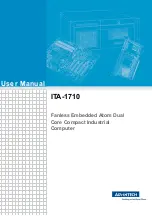
16
|
7 SERVICING AND TROUBLESHOOTING
HAZARDOUS VOLTAGES EXIST WITHIN THE SRF ENCLOSURE.
THE SRF SHOULD ONLY BE SERVICED BY QUALIFIED
PERSONNEL, IN ACCORDANCE WITH RELEVANT NATIONAL
ELECTRICAL & SAFETY CODES.
Do not disconnect upstream earth or neutral connections
supplying the SRF while power is applied to the unit, as this
may damage the SRF or load.
Only replace the primary spark gaps or secondary TDS surge
diverters with an identical type.
Voltage-free alarm contacts are activated should the secondary
protection status fall below a pre-determined level.
The SRFs are essentially maintenance free, although periodic
inspection is recommended to ensure that the ventilation
louvres (where fitted) do not become clogged with dust.
INITIAL POWER CHECK
All indicators, alarms and surge counters (where fitted) should
be checked on a regular basis.
Should any of the display indicators fail to illuminate, check for
the following conditions:
• Is power available to the SRF?
• Check the input voltage by measuring the voltage between
active and neutral
• Has the upstream circuit breaker or fuse tripped?
INDICATORS
If power is being supplied to the SRF and the indicators still
fail to all correctly illuminate, then it is possible that either the
primary Spark Gap or secondary TDS devices have exhausted
their surge capacity. In such circumstances, the particular
devices should be replaced as a matter of urgency as they are
no longer providing optimum protection.
PRIMARY SPARK GAPS
With power correctly supplied, the Phase Spark Gaps should have
their green LEDs illuminated. Note that in the 250A to 800A SRFs,
these Spark Gaps are supplied via Spark Gap Fuses. If power is
correctly applied, and a Phase Spark Gap does not have its LED
illuminated, check the adjacent fuse. If the fuse has operated
(blown) it needs to be replaced. If the fuse is still in good order, the
Spark Gap needs to be replaced. Blown fuses may be temporarily
replaced with a 125A 22mm x 58mm gG Fuse. Note that this fuse
will not allow the full rated surge current to be diverted by the
associated Spark Gap. The correct replacement fuse should be
obtained from nVent as soon as possible.
Note that the N-E Spark Gap does not have an LED.
SECONDARY UNITS
The Secondary Units are blue in colour and contain the
secondary shunt diverter module and the filter capacitance
(see Figure yy). They are fed from individual 20A fuses. The
Phase 1 Secondary Unit is fitted with the Alarm Contacts, and it
is marked as SRFSUAC. On three phase units, the Phase 2 and
Phase 3 Secondary Units are marked as SRFSU. The status of
each SRFSUAC and SRFSU unit is indicated by the green LED
included on each. A correctly powered and operating SRF will
have all Secondary Unit LEDs illuminated green.
A Secondary Unit LED that is not illuminated indicates one of
the following:
• A blown Secondary Unit Fuse (replace Fuse)
• A failed Diverter Module (replace Module)
• An SRFSU or SRFSUAC internal failure (replace SRFSU or
SRFSUAC unit)
Troubleshooting proceeds in the order indicated here:
1) Check fuses for continuity, and replace blown fuses with 20A
10mm x 38mm gG fuses.
2) Check Diverter Module indicator flags. These should appear
as the textured window, with a faint grey/red tinge. Any window
showing a bright red colour should be replaced. Modules may
be gripped with the fingers and pulled straight out, away from
the Secondary Unit. Replace with an identical module obtained
from nVent.
3) Where all fuses and modules have been checked as OK,
then the affected Secondary Unit itself needs replacing
(ie the SRFSUAC or SRFSU unit).
Phase 1
SRFSUAC
LED Status
Phase 2
SRFSU LED
status
Phase 3
SRFSU LED
Status
Diagnosis
Green
Green
Green
All OK
Extinguished Green
Green
Replace Phase 1
SRFSUAC unit
Extinguished Extinguished Green
Replace Phase 2*
SRFSU unit
Extinguished Green
Extinguished Replace Phase 3*
SRFSU unit
*It is possible that both the Phase 1 SRFSU and Phase 2
(or 3) SRFSU units are faulty in this circumstance, but the
above diagnosis is more likely.
Obtain the correct model Secondary Unit (SRFSUAC or SRFSU)
from nVent and wire in to replace the faulty unit. Exercise care
when replacing the wiring to ensure the resulting wiring is
correct. It may be useful to take a photograph before removing
the faulty unit.
FRONT DOOR LED INDICATOR
This indicator will be illuminated green if all Secondary Units
are indicating correctly.
Installation and Operating Instructions





































